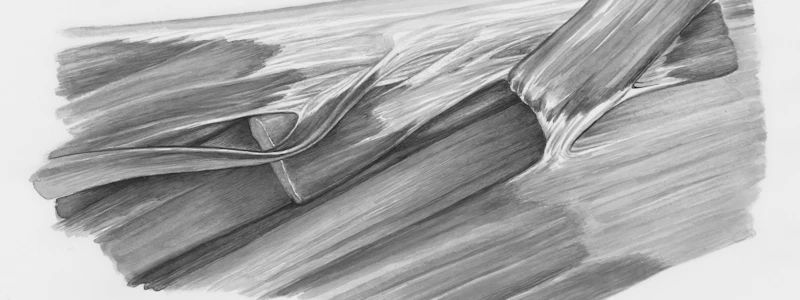Podcast
Questions and Answers
Tuberculosis tibia ve tutunan ligament aşağıdakilerden hangisidir?
Tuberculosis tibia ve tutunan ligament aşağıdakilerden hangisidir?
- Ligg. Patellare fibular
- Ligg. Collaterale tibiale posteriure (correct)
- Ligg. Collaterale fibuläre
- Ligg. Patellare
- Ligg. Cruciatum anterior
Tarsal tibia kemiklerinden hangisi ile eklem yapmaz?
Tarsal tibia kemiklerinden hangisi ile eklem yapmaz?
- Fibula (correct)
- Os naviculare
- Os cuboideum
- Tibia
- Calcaneus
Aşağıda verilen kas ve görev eşleştirmelerinden hangisi yanlıştır?
Aşağıda verilen kas ve görev eşleştirmelerinden hangisi yanlıştır?
- M. Risorius - ağız köşelerini alt dudağa doğru indir
- M. Correptor superficialis - kaşları yukarıya kaldırılmasını sağlar (correct)
- M. Nasalis pars transverse - burun deliklerini daraltır.
- M. Depressor labii inferior - kas dudak aşağıya doğru indiri
- M. Orbicularis oris - dudakların çapraz kapatılma
Aşağıdakilerden hangisi humerusun distal ucunda yer alan oluşumlardan biri değildir?
Aşağıdakilerden hangisi humerusun distal ucunda yer alan oluşumlardan biri değildir?
Aşağıda verilen kaslar işlevleriyle ilgili eşleştirmelerden hangisi yanlıştır?
Aşağıda verilen kaslar işlevleriyle ilgili eşleştirmelerden hangisi yanlıştır?
Aşağıdakilerden hangisi suprahyoid kaslardan biri değildir?
Aşağıdakilerden hangisi suprahyoid kaslardan biri değildir?
Aşağıdaki kaslardan hangisi omuza iç rotasyon yaptıran kaslardan biri değildir?
Aşağıdaki kaslardan hangisi omuza iç rotasyon yaptıran kaslardan biri değildir?
Çiğneme kaslarının motor siniri ve minik kaslarını innere eden sinir sırasıyla hangi şıkta doğru verilmiştir?
Çiğneme kaslarının motor siniri ve minik kaslarını innere eden sinir sırasıyla hangi şıkta doğru verilmiştir?
Aşağıdaki kaslardan hangisi karın ön ve yan duvarlarında yer almaz?
Aşağıdaki kaslardan hangisi karın ön ve yan duvarlarında yer almaz?
I - M. deltoideus
II - M. supraspinatus
III - M. infraspinatus
IV - M. teres minor
V - M. teres major
Yukarıdaki kaslardan hangileri kolda dış rotasyon yaptırır?
I - M. deltoideus II - M. supraspinatus III - M. infraspinatus IV - M. teres minor V - M. teres major Yukarıdaki kaslardan hangileri kolda dış rotasyon yaptırır?
Aşağıda verilen kaslardan hangisi uyluğa abdüksiyon yaptırn kaslardan biri değildir?
Aşağıda verilen kaslardan hangisi uyluğa abdüksiyon yaptırn kaslardan biri değildir?
Kalça bölgesinin en güçlü flexor kası aşağıdakilerden hangisidir?
Kalça bölgesinin en güçlü flexor kası aşağıdakilerden hangisidir?
Ayağa inversyon yaptıran kas aşağıdakilerden hangisidir?
Ayağa inversyon yaptıran kas aşağıdakilerden hangisidir?
Adduksiyon hariç, omuzun bütün hareketlerinde çalışan kas aşağıdakilerden hangisidir?
Adduksiyon hariç, omuzun bütün hareketlerinde çalışan kas aşağıdakilerden hangisidir?
Omuzun hızlı ve kuvvetli supinasyon hareketini hangi kas yapar?
Omuzun hızlı ve kuvvetli supinasyon hareketini hangi kas yapar?
Uyluğun adductor kaslarından hangisinin hem art. Genus hem de art. Coxae üzerinde etkisi vardır?
Uyluğun adductor kaslarından hangisinin hem art. Genus hem de art. Coxae üzerinde etkisi vardır?
Flashcards
What ligament attaches to the tibial tuberosity?
What ligament attaches to the tibial tuberosity?
The ligament that connects the tibial tuberosity to the patella, contributing to knee stability.
Which bone does the talus not articulate with?
Which bone does the talus not articulate with?
The talus does not articulate with the fibula.
Which muscle/function combination is incorrect?
Which muscle/function combination is incorrect?
The combination of muscle and function is incorrect, requiring you to find the mismatch. Review each option for accuracy.
What structures are found on the distal end of the humerus?
What structures are found on the distal end of the humerus?
Signup and view all the flashcards
Match muscles to their functions.
Match muscles to their functions.
Signup and view all the flashcards
What is the tibial tuberosity?
What is the tibial tuberosity?
Signup and view all the flashcards
What is the talus?
What is the talus?
Signup and view all the flashcards
Describe the structures on the distal end of the humerus.
Describe the structures on the distal end of the humerus.
Signup and view all the flashcards
What is involved in matching muscles to their functions?
What is involved in matching muscles to their functions?
Signup and view all the flashcards
What is the role of the patellar ligament?
What is the role of the patellar ligament?
Signup and view all the flashcards
Study Notes
Question 1
- Tibial tuberosity is connected to ligaments
- Correct answer: Ligamentum collaterale tibiale
Question 2
- Talus does not articulate with cuboid bone.
Question 3
- Incorrect matching of muscle and function
- Correct answer: M. Corrugator supercilii raises eyebrows
Question 4
- Distal humerus does not contain the fossa radialis
- Correct answer: Trochlea humeri
Question 5
- Incorrect matching of muscle and function
- Correct answer: M. Gemellus inferior external rotation of hip
Question 6
- Incorrect muscle
- Correct answer: m. stylohyoideus
Question 7
- Muscle not involved in internal rotation of the shoulder
- Correct answer: Muscle suprasinatus
Question 8
- Trigeminal nerve branches innervate chewing muscles while facial nerve innervates facial muscles
- Correct answer: n. trigeminus V3, and n. facialis
Question 9
- Muscle not part of abdominal wall
- Correct answer: M. quadratus lumborum
Question 10
- Muscles responsible for external rotation of the arm
- Correct answer: M. infraspinatus, M. teres minor, M. teres major
Question 11
- Muscle not responsible for abduction of the thigh
- Correct answer: M. sartorius
Question 12
- Most potent hip flexor
- Correct answer: m. iliopsoas
Question 13
- Muscle responsible for foot inversion
- Correct answer: M. tibialis posterior
Question 14
- Muscle that participates in all shoulder movements except abduction
- Correct answer: M. deltoideus
Question 15
- Muscle(s) responsible for rapid supination of forearm
- Correct answer: M. supinator
Question 16
- Muscle involved in both hip and knee actions
- Correct answer: M. adductor magnus
Studying That Suits You
Use AI to generate personalized quizzes and flashcards to suit your learning preferences.
Description
Test your knowledge on human anatomy with this quiz focusing on muscles, ligaments, and nerve innervations. Questions cover various aspects, including muscle functions and the connections of bones and ligaments. Perfect for anatomy students and enthusiasts alike!




